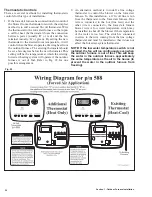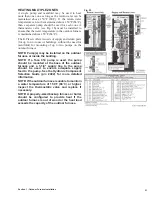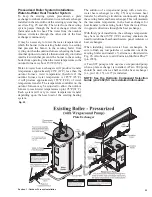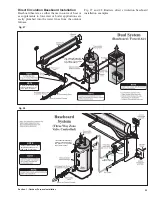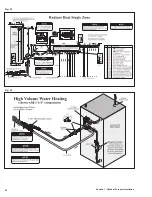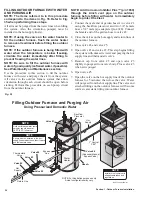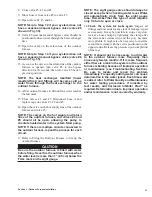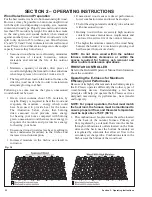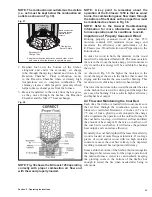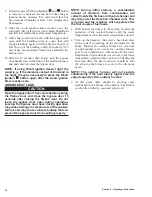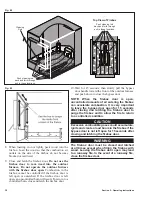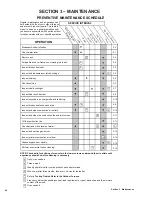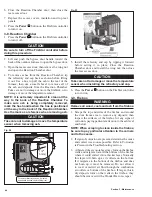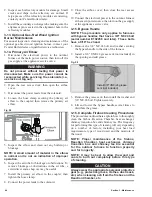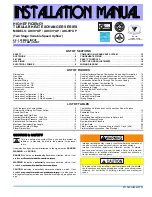
31
Section 1 - Outdoor Furnace Installation
8. Close valve #5, #1 and #2.
9. Move hose A from valve #2 to valve #3.
10. Open valves #1, #3 and #4.
NOTE: Skip to Step 12 if your system does not
have a seasonal manual bypass valve (valve #6
shown in Fig. 35).
11. Valve #6 (seasonal manual bypass valve) should be
positioned to direct water through the heat exchanger
first.
12. Open the valve on the return line of the outdoor
furnace.
NOTE: Skip to Step 14 if your system does not
have a seasonal manual bypass valve (valve #6
shown in Fig. 35).
13. As soon as the valve on the return line of the outdoor
furnace is opened, turn valve #6 to the bypass
direction for 30 seconds; then turn valve #6 back to
previous position.
NOTE: The heat exchanger manifold (lower
manifold first) and fittings will become cold as
water flows through the heat exchanger to the
outdoor furnace.
14. Allow outdoor furnace to fill until the water reaches
the full mark.
15. Close valves #1 and #3. Disconnect hose A and
replace caps on valves #1, #2 and #3.
16. Open the valve on the hot supply line of the outdoor
furnace and valve #5.
NOTE: The valves on the hot supply and return
lines of the outdoor furnace, and valves #4 and
#5 should all be open, allowing the pump to
circulate heated water in the system. Start pump.
NOTE: If there are multiple circuits connected to
the outdoor furnace, repeat the process for each
circuit.
17. Refer to Firing the Outdoor Furnace to fire up the
outdoor furnace.
CAUTION
Be sure the outdoor furnace is filled with water
before firing. Never fire the outdoor furnace when
the water level is more than 1" (2.5 cm) below the
FULL mark on the sight gauge.
NOTE: The sight gauge valve should always be
closed except when checking water level. Water
will automatically drain from the sight gauge
tube. Remember that this type of valve requires
only 1/4 turn to open or close.
18. Check the system for leaks again. Inspect all
fittings and hose ends for any signs of leakage; repair
as necessary. It may be possible to stop a very slow
leak at a hose clamp by tightening the clamp after
the system has warmed up and the poly becomes
more pliable. It might also be necessary to install a
second hose clamp with the screw positioned on the
opposite side. Release the pressure upon completion
of the test.
NOTE: It should not be necessary to add water
to the outdoor furnace more frequently than
once every twelve months. If it is more frequent,
either there is a leak in the system or the outdoor
furnace is boiling because of improper operation
or maintenance (see Troubleshooting Section).
Be sure to locate and repair the problem
immediately. Frequently adding water can cause
deterioration in the water jacket. Each time water
is added, refer to Water Quality and Maintenance
for water testing procedures. If indicated by
test results, add Corrosion Inhibitor Plus™ as
required. Deterioration due to improper operation
and/or maintenance is not covered by warranty.
Summary of Contents for e-Classic 1450 IR
Page 17: ...15 Section 1 Outdoor Furnace Installation...
Page 29: ...27 Section 1 Outdoor Furnace Installation Fig 30 Fig 31...
Page 30: ...28 Section 1 Outdoor Furnace Installation Fig 32 Fig 33...
Page 66: ...64 E CLASSIC 1450 WIRING DIAGRAM Section 6 General Information...
Page 67: ...65 Section 6 General Information E CLASSIC 1450 WIRING DIAGRAM OPTIONAL POWER IGNITION...
Page 69: ...67 NOTES...
Page 70: ...68 NOTES...
Page 71: ...69 NOTES...




